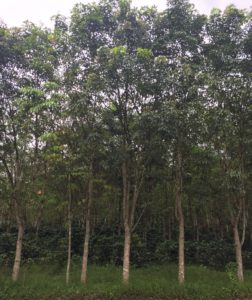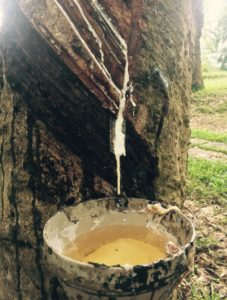Other names: Natural rubber, Crepe Rubber, India rubber, Caoutchouc
Natural rubber consists of polyisoprenes (polymers of isoprene), with minor impurities of other organic compounds and water. In most of its useful forms, it has a large stretch ratio, high resilience, and is waterproof.
It is mainly harvested from the Hevea brasiliensis ‘rubber tree’, and we us more of it globally each year than synthetic rubber. Originally from Brazil, the major producers are now Thailand, Indonesia, and other countries in South and East Asia. Rubber plantations have resulted in significant loss of rainforest.
Other plant species bearing rubber and rubber-like hydrocarbons:
Guayule (Parthenium argentatum), Rabbit-Brush (Crysothamnus nauseousus), Rubbervine (Cryptostegia grandiflora), Taraxacum krim–saghyz, Taraxacum kok-saghyz, Scorzonera tau-saghyz, Scorzonera Uzbekistanica, Scorzonera taka-saghyz, Milkweeds (Asclepias incarnata, sub-lata, syrica, et al), Goldenrods (Solidoago altissima, graminifolia, leavenworthii, rigida, et al), Sow thistles (sonchus arvensis, oleraceous, et al), Rosin weeds (Silphium species), Mountain Mints (Pycnanthemum species), Cacalia atriplicifolia
Uses
There are countless uses of rubber including:
- Car tyres
- Shoe soles
- pencil erasers
- birthday balloons
- condoms
- protective gloves
- adhesives (such as sticky white PVA)
- paints
- roofing membranes
- waterproof butyl liners in garden ponds
- rigid inflatable boats (RIBs) used by scuba divers
- jacketing material for electrical cables, fiber-optic cables, and heat pipes
- artificial hearts (in the rubber diaphragms that pump blood)
- waterproof gaskets that seal the doors on washing machines
Potential Uses
No new uses identified by authors. Your contributions welcome!
Processes
Currently, most rubber is harvested as latex (a sticky, milky colloid) from the rubber tree. It is drawn off by “tapping”; making incisions in the bark and collecting the fluid in vessels, which is then refined into rubber ready for commercial processing. Rubber trees must reach 8 to 10 years of age before producing latex. The trees are usually felled after 30 years of harvesting as the yield drops off.

Rubber is harvested by making incisions in the bark and collecting the latex fluid, a process known as tapping. The latex is a sticky, milky colloid. The latex is allowed to coagulate and processed, including several stages of washing and heating.

Ancient Mesoamerican civilizations used the sulfur from the juice of the Morning glory plant to vulcanize the latex from the Castilla elastica tree and the guayule plant to produce bouncing balls for games, amongst other uses.
More Information
- http://www.explainthatstuff.com/rubber.html
- https://en.wikipedia.org/wiki/Natural_rubber
- https://www.heddels.com/2018/02/crepe-rubber-what-is-it-and-where-does-it-come-from-2/
